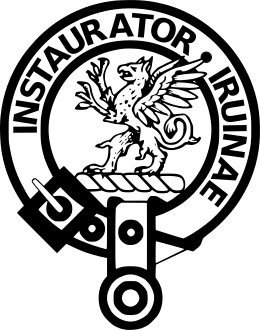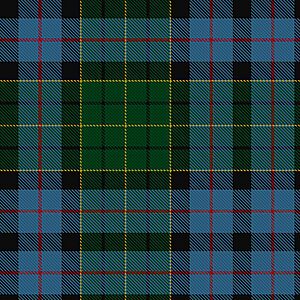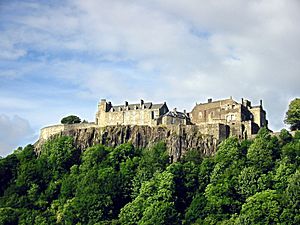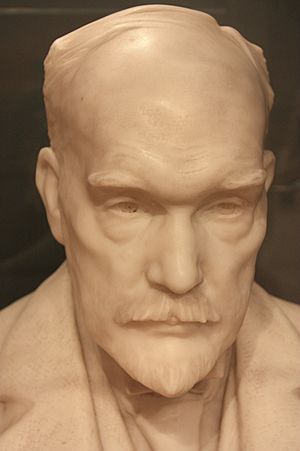Clan Forsyth facts for kids
Quick facts for kids Clan Forsyth |
|
|---|---|
| Fearsithe | |

Crest: A griffin sergeant Azure, armed and membered Sable, crowned Or
|
|
| Motto | Instaurator ruinae (A repairer of ruin) |
| Profile | |
| Region | Lowlands |
| Chief | |
 |
|
| Alistair Forsyth of that Ilk | |
| Chief of the Name and Arms of Forsyth | |
| Seat | Ethie Castle |
| Historic seat | Forsyth Castle Inchnoch Castle |
Clan Forsyth is a Scottish clan with a long and interesting history. The name "Forsyth" might come from the Scottish Gaelic word Fearsithe, which means "man of peace." Another idea is that the name comes from a Norman knight named Forsach, whose family settled in France and later moved to Scotland.
Contents
History of Clan Forsyth
Where the Clan Began
The history of Clan Forsyth goes back a very long time, even before the 1100s. No one is completely sure where the name comes from. If the name is Celtic, it might come from Fearsithe, which means "man of peace" in Scottish Gaelic.
However, another story says the name is Norman. It might come from a knight named Forsach. He was one of the Norsemen (Vikings) who settled in France. A nobleman from this family, Viscomte de Fronsoc, came to England in 1236. He lived at the English court for about ten years. His family might have gotten land in Northumberland, England, and then moved to the Scottish Borders.
Fighting for Scottish Independence
In 1296, a man named William de Fersith signed a document agreeing to obey King Edward I of England. Later, after 1306, Osbert, the son of Robert de Forsyth, was given land in Stirlingshire by King Robert the Bruce.
During the Wars of Scottish Independence, Osbert fought bravely at the Battle of Bannockburn. He was rewarded for his courage and his land ownership was confirmed in 1320. In 1368, Osbert's son became the king's macer (a royal attendant) and the constable of Stirling Castle. The Forsyth family became well-known around Stirling.
The 1400s, 1500s, and 1600s
Around 1488, David Forsyth of Dykes got land in Lanarkshire. He believed his family came from the de Fronsocs and his family crest looked similar to theirs. Forsyth Castle at Dykes was taken down in 1828. A part of the clan moved from Dykes to Inchnoch Castle. Their family members then spread out across Glasgow and Ayrshire.
William Forsyth was a leader in Edinburgh around 1365. His son, also named William, moved to St Andrews in 1423. He later bought the barony of Nydie. Alexander, the fourth Baron of Nydie, died at the Battle of Flodden in 1513. His grandson, James, married Elizabeth Leslie. She was related to the Earl of Rothes and James III of Scotland. The Forsyths became powerful through these family connections. They also got land near the royal Falkland Palace. John Forsyth became the king's macer in 1538. The current chiefs of Clan Forsyth are descendants of these Falkland Forsyths.
The 1700s, 1800s, and 1900s
Another part of the Clan Forsyth settled near Monymusk. William Forsyth represented the town of Forres in Parliament in 1621.
Alexander John Forsyth was important in developing modern firearms. In the 1700s, his work helped change how guns worked, moving from the old flintlock system to the percussion lock.
William Forsyth (born 1737) was a famous gardener. He went to London to study botanical gardens. In 1784, he became the Chief Superintendent of the royal Kensington Gardens and St James's Palace.
Peter Taylor Forsyth (born 1848) was a college principal. In 1909, he published his most important book, The Person and Place of Jesus Christ.
Robert Wallace Forsyth (born 1843) started his own chain of department stores, R.W. Forsyth, in Glasgow in 1872. By 1925, his business had grown to Edinburgh and London. The family owned the business for 111 years until it was sold in 1983. A statue of Forsyth is on display at the People's Palace, Glasgow.
Clan Chief
In 1672, King Charles II started a public list of all the clans. However, the Forsyth chief at that time refused to sign up. Because of this, the clan lost its official recognition and the chief lost his legal title. This lasted for 300 years.
Then, on St. Andrews Day in 1978, the Lord Lyon, King of Arms (who manages Scottish heraldry and clans), accepted Alistair Forsyth's claim to be the Chief of the Forsyth clan. Alistair Forsyth, the Baron of Ethie, now lives in Western Australia.
Clan Castles
The Clan Forsyth has been connected to several castles throughout history:
- Ethie Castle, Angus & Dundee: This castle is about five miles northeast of Arbroath. It is now privately owned.
- Inchnoch Castle, Lanarkshire & Glasgow area: This castle is about two and a half miles north of Coatbridge. Only small parts of the old tower house remain today.
- Dykes Castle, Lanarkshire & Glasgow area: This castle is about two miles west of Stonehouse. It is now a ruin. The Forsyth family owned Dykes for a long time and built a castle here around 1350. The story says they got the land after defeating an English force.
- Nydie Castle, Fife: This castle is about five miles west of St Andrews. It is also a ruin. The Forsyth family owned Nydie from 1435 to 1608.
- Polmaise Castle, Stirlingshire & Clackmannan: This castle is about three miles east of Stirling, near the River Forth. It is now a ruin. The Forsyths were given the lands of Polmaise Marischal in the 1300s.
- Ecclesgreig Castle, Aberdeenshire: This castle is northwest of St Cyrus. It was also known as Criggie and Mount Cyrus. The Forsyth-Grants family gave it the name Ecclesgreig after 1843. The house is now a ruin and is privately owned.
See also
- Scottish clan
- Forsyth (surname)
- Ethie Castle, the current home of the Clan Chief.
- William Forsyth (merchant)
- James W. Forsyth
- Forsyth, Montana
- John Forsyth (loyalist)




